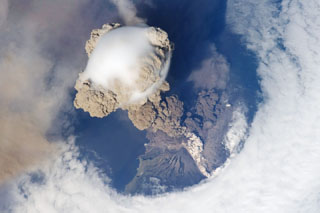Report on Sarychev Peak (Russia) — April 1987
Scientific Event Alert Network Bulletin, vol. 12, no. 4 (April 1987)
Managing Editor: Lindsay McClelland.
Sarychev Peak (Russia) Lava flow and gas emissions
Please cite this report as:
Global Volcanism Program, 1987. Report on Sarychev Peak (Russia) (McClelland, L., ed.). Scientific Event Alert Network Bulletin, 12:4. Smithsonian Institution. https://doi.org/10.5479/si.GVP.SEAN198704-290240
Sarychev Peak
Russia
48.092°N, 153.2°E; summit elev. 1496 m
All times are local (unless otherwise noted)
In September 1986 the staff of a meteorological station on Matua Island reported a strong sulfur smell. During the previous observations, after the 1976 eruption, the crater was described as flat-bottomed with a depth of 50-70 m by Andreyev and others (1978). During the 2 November 1986 overflight only the SE wall remained above the crater. Gas was being emitted from most of the crater, with the most intense fumaroles restricted to its central and W parts. A black, snow-free lava tongue extended 100-150 m from the S part of the crater. Many shallow fumaroles were located in the SE part of the crater and at the head of the lava flow. Gas emission was not observed from the lava flow itself. Traces of ash that fell before September 1986 were noted on the snow-covered crater slopes. The volcano has no permanent snow cover.
Reference. Andreyev, V.N., Shantser, A.Ye., Khrenov, A.P., Okrugin, V.M., and Nechayev, V.N., 1978, Eruption of the volcanic peak Sarycheva in 1976: Byull. Vulkanol. Stn., no. 55, p. 35-40.
Geological Summary. Sarychev Peak, one of the most active volcanoes of the Kuril Islands, occupies the NW end of Matua Island in the central Kuriles. The andesitic central cone was constructed within a 3-3.5-km-wide caldera, whose rim is exposed only on the SW side. A dramatic 250-m-wide, very steep-walled crater with a jagged rim caps the volcano. The substantially higher SE rim forms the 1496 m high point of the island. Fresh-looking lava flows, prior to activity in 2009, had descended in all directions, often forming capes along the coast. Much of the lower-angle outer flanks of the volcano are overlain by pyroclastic-flow deposits. Eruptions have been recorded since the 1760s and include both quiet lava effusion and violent explosions. Large eruptions in 1946 and 2009 produced pyroclastic flows that reached the sea.
Information Contacts: G. Steinberg and B. Piskunov, Yuzhno-Sakhalinsk.

